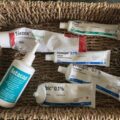
Here are my 10 tips for getting the most out of your dermatology appointment, because I’ve been there. I’ve left crying, feeling angry, misunderstood and worthless.
I want you to get the most out of your appointments, and over the years I’ve perfected the art. I think my derm is actually a little bit scared of me now, ever since at my last appointment I gave him a copy of my book, The Shape of Skin eczema poems, with the angry dermatology rant poems carefully marked with post it notes for him.
I hope you find this list useful…
- Be clear about your objectives – Work out what you want from the appointment. Are you happy with your skin? or do you need help with moisturising? Skin flares? Do you want to discuss certain treatments? It’s Ok not to have all the answers, it may be a fact finding mission, but make the most of your appointment. The worst thing is getting home and finding you didn’t ask important questions.
- Make notes – This might sound obvious but doctors can often say quite a lot of stuff, using technical terms and it’s not till afterwards that we think to question. Words like nodular prurigo, excoriation, lichenification etc. I remember the day I actually discovered the name for the huge, hard, itchy lumps I’d been getting, which used to be so itchy and bleed so much when the skin was broken – they’re called nodular prurigo and discovering what they were meant I could do my own further research to find out what I could do about them.
- Take pictures – When you skin is at it’s worst, strange flares, symptoms you wish to discuss, snap a photo. Document your skin and show your doctor. Create a folder on your phone so you can show the pictures that are relevant at your appointment.
- Take research documents – Depending what you want to talk about, often your GP may not be aware of new treatments or progress. Certainly trying to educate my dermatologist about topical steroid withdrawal is a constant battle. Print out documents and take them with you so can leave them for them to read. There are few studies on TSW, would print these and take a copy with you. Particularly if you’re struggling to the help you think you deserve. It can be difficult. If you think you are addicted to topical steroids or are going through Topical Steroid Withdrawal you may find help here – TSW FAQ.
- Call out gaslighting – This happens a lot and it’s not OK. If you feel strong enough, call it out. Explain simply and firmly that you are not stupid, you are the expert of your skin and you know what is going on. I know this isn’t easy to do though and countless times I’ve left appointments in tears. Pick your battles but try to let them know you do not feel well served by them.
- Don’t be fobbed off – If you do get fobbed off, or gaslit to hell, stand your ground. Even if you leave disappointed, follow it up. Don’t let them fob you off. And if you are really disappointed with your treatment, you can report and ask for further advice through PALS – The Patient Advice and Liaison Service through the NHS.
- Talk about your feelings, not just your skin – If your mental health is suffering, tell your GP and your dermatologist. We have to communicate about how hard it is, but the message is getting there. It is now widely known how tough it is living with a chronic skin condition – it affects every aspect of our lives and it’s really hard to live with. You may be able to request some counselling, CBT or other therapy so do push for this. It may not be available and I want to explore whether there are options out for for private treatment too. Watch this space! I had therapy for my fear or anaphylaxis a few years ago and it became apparent that my feelings are all wrapped up in guilt, shame and loathing of my skin too and it really helped me to learn to love my skin and look at better ways of coping. Read ’10 tips for getting therapy for fear of anaphylaxis’ because it definitely applies to our skin struggles and feelings also.
- Ask for an email address – My dermatologist and dietician are open and welcome me contacting them outside my appointments, if I have questions, want advice or need help. Ask if this is available to you because it’s often when we get home that think of what we really wanted to say. If you do think you have TSW you can also download a letter that you send via post of email to your GP or dermatologist prior to your appointment or afterwards as follow up. Download Sample letter explaining TSW
- Ask what other options or treatments are available – Find out what’s out there, what you could do and do all the research. There might be something that you really like the sound of like UVB therapy, allergy testing, patch testing, ask what you can consider.
- Ask what they would try themselves – I’ve often been concerned when I’ve asked a dermatologist directly, looking them in the eye and asking, “If you had eczema, would you take this medication? Use this cream?” If they struggle to respond and can’t look you in the eye, you have your answer.
I hope you find some help here, it’s not easy getting the help you need when doctors don’t have time or don’t seem to understand how hard it is living with a chronic skin condition. I would love to hear your experiences and tips.
Photo by SHVETS production from Pexels
You may also find the following of interest
- 5 Terms your dermatologist uses that you might not understand By Melissa Haller Tanoko, National Eczema Association.
- A dermatologist review of The Shape of Skin, poetry for people with eczema
- Skin on Fire TSW Documentary reviewed
- Protopic usage, tapering and withdrawal












Leave a Reply